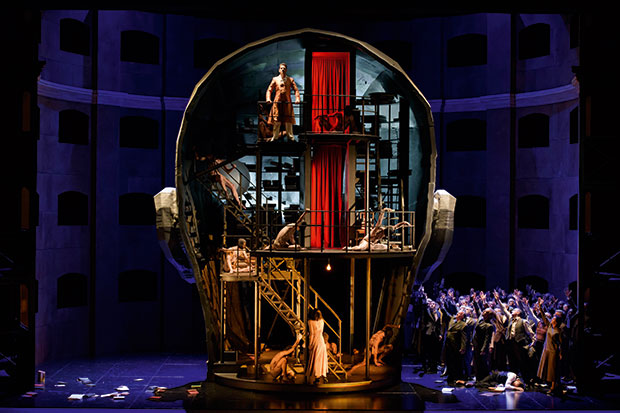‘What gives your lies such power?’ asks the bewildered Sicilian leader in Szymanowski’s opera Krol Roger. The question is addressed to a charismatic shepherd, on trial for propagating a lascivious new religion of unbridled sensuality. Roger’s wife, Roxana, has already converted along with many of his subjects, while the city’s conservative and clerical factions clamour for the blasphemer’s death. But Roger resolves to see for himself.
Or rather hear for himself. For although the shepherd’s uncanny beauty is clear for all to see, his real power comes from the music, whose snaking contour weaves its eerie magic round the listener and disorientates him, disarming power of judgment by replacing its hard ground with something soft, pleasurable but alarmingly shapeless.
Plato wouldn’t have stood for it. Musical innovation, he warned, should be prohibited as a danger to the state. So grounded is our moral character in our sense of musical harmony and rhythm that substantial alteration necessitates an entirely new system of government. This, above all, is what is at play in Szymanowski’s opera: the collision of two musical systems, ways of believing and seeing, which yield after a long struggle to a third way in which the Apollonian virtues of order and balance become energised through exposure to the darker, destructive forces of Dionysus.
Krol Roger is in this sense an ideal opera because, as in Wagner’s Tristan und Isolde, its dramatic content is quite literally heard through the music. And what tremendous music it is, subtly and exotically scored with moments of bewitching beauty and earth-shattering power. It opens, in total darkness, with a simple Byzantine hymn, with primitive harmonisations and a hesitant mantra beaten out on a tam-tam. The style and texture bloom gradually, increasing in polyphonic complexity and force to reveal the awful power of God and the wonder of his human representative, Roger. As soon as doubt enters the King’s mind, the harmony starts to slide and twist, its increasingly chromatic contours tangling his thoughts and confounding his customary sense of purpose.
As with Tristan, the force of the opening ten minutes is enough to hook you in for the duration. Unlike Tristan, however, Szymanowski’s opera is brief, its three acts barely overreaching 90 minutes. It is also rarely heard, perhaps because of its Polish libretto. The main source is Nietzsche’s Birth of Tragedy, but the action derives from Euripides’ Bacchae, albeit given a Nietzschean ending.
Szymanowski disguised the Euripidean origin behind a historical setting of Norman Sicily during the reign of Roger II, a king still remembered today for the skill with which he managed political and cultural change, accommodating the religious needs of his largely Muslim subjects and flirting with the Eastern church to press his advantage against Rome. Roger’s legacy is immediately visible to any visitor to Palermo, in the way the traces of successive civilisations are woven in its architecture like layers of peeling wallpaper.
Staging the work at Covent Garden for the first time in the company’s history, Kasper Holten and Antonio Pappano are to be congratulated wholeheartedly. Pappano surpasses himself in his detailed preparation of the score and minute command of the pacing so that the musico-dramatic tension, though often unbearably intense, never loses its thread nor becomes excessive. Holten and his designer, Steffen Aarfing, have followed many of the composer’s staging instructions, using a giant head of Apollo instead of the face of Christ, upon which the evening lights play menacingly with its inscrutable expression. In the second act, the head revolves to reveal the palace apartment in which Roger wrestles with his fears and weighs his learning against the anarchic forces of the Shepherd. These take the physical shape of a tangled mass of writhing dancers, maenads, who are awakened by the music of doubt and later ransack the palace, destroying Roger’s books.
There is a sense, perhaps, that Holten’s psychoanalytic focus — with the drama unfolding ‘inside’ Roger’s head — is a little too exclusive. Certainly, the final act is weakest, rather lacking a sense of how the fruits of Roger’s mental struggle might bear on the fate of his scattered subjects. But the opera’s dramatic force remains palpable throughout thanks to the clarity of Holten’s underlying conception and his unfussy direction of the singers who are, by and large, left in relative peace to find their space and sing from it. This is particularly good because the sense of dynamism comes from the pit (too much stage busyness would simply dilute it) and also because the soloists need all their strength to project above the volatile orchestral texture. The Polish baritone Mariusz Kwiecien, suitably experienced in the role, gives a tremendously focused performance, his thick baritone wet with unsettled might and anguish. Georgia Jarman’s Roxana projects a suitably dreamy, absent-minded voluptuousness, while Saimir Pirgu’s Shepherd, his white clothes and teeth gleaming out from his golden frock-coat, is beautifully pitched, his even tenor seeming effortlessly to draw all other sounds into itself. The chorus, directed by Renato Balsadonna, rises magnificently to the occasion.






Comments